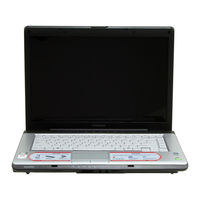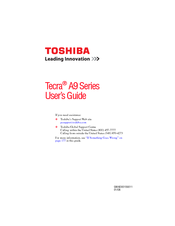Toshiba A9-S9018V - Tecra - Core 2 Duo 2.1 GHz Manuals
Manuals and User Guides for Toshiba A9-S9018V - Tecra - Core 2 Duo 2.1 GHz. We have 2 Toshiba A9-S9018V - Tecra - Core 2 Duo 2.1 GHz manuals available for free PDF download: User Manual
Toshiba A9-S9018V - Tecra - Core 2 Duo 2.1 GHz User Manual (245 pages)
A205-S5800 User's Guide
Table of Contents
-
Introduction35
-
This Guide36
-
Safety Icons37
-
-
-
-
-
Battery Notice105
-
Power Management106
-
-
Traveling Tips121
-
-
Web Cam133
-
Using PC Cards134
-
-
TOSHIBA Assist141
-
Connect142
-
Secure143
-
Protect & Fix144
-
Optimize145
-
-
Mouse Utility153
-
Configfree170
-
Getting Started171
-
-
-
-
-
A Plan of Action180
-
Memory Problems182
-
Display Problems185
-
PC Card Problems190
-
Printer Problems194
-
Modem Problems194
-
-
-
Hot Key Cards208
-
-
Card Case211
-
-
Volume Mute213
-
Power Plan215
-
Sleep Mode216
-
-
Hibernation Mode217
-
Display Modes218
-
Advertisement
Toshiba A9-S9018V - Tecra - Core 2 Duo 2.1 GHz User Manual (245 pages)
A9-S9018V User's Guide
Table of Contents
-
Introduction35
-
This Guide36
-
Safety Icons37
-
-
-
-
-
Battery Notice103
-
Power Management104
-
-
Traveling Tips120
-
-
Using PC Cards131
-
-
TOSHIBA Assist138
-
Connect139
-
Secure140
-
Protect & Fix141
-
Optimize142
-
-
Mouse Utility153
-
Configfree173
-
-
-
-
A Plan of Action183
-
Memory Problems185
-
Display Problems188
-
PC Card Problems193
-
Printer Problems195
-
Modem Problems196
-
-
-
Hot Key Cards209
-
-
Card Case212
-
-
Volume Mute214
-
Power Plan216
-
Sleep Mode217
-
Hibernation Mode218
-
Display Modes219
-
-
Advertisement

